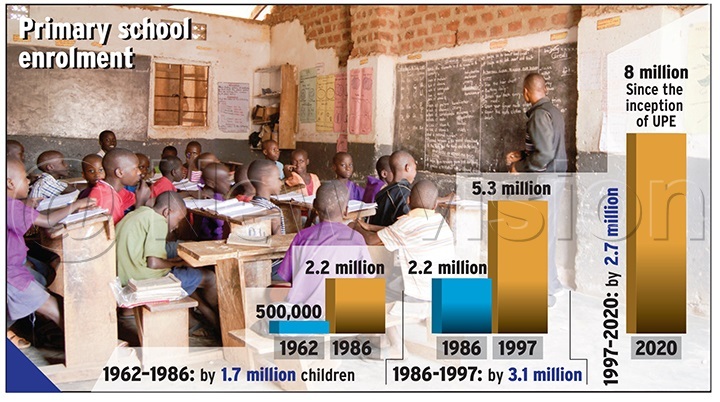Museveni pushes for technical institutes
Besides, UPE and USE, there was need for the government to cater for the students who completed O'level, so the UPOLET (free A'level education) programme was approved by Cabinet in 2011 and its implementation commenced the year after.
SPONSORED CONTENT
Over the last five years, there has been a registered increase in the stock of teachers' houses.
There are close to 15,000 teachers' houses around the country. The secondary education curriculum has also been reviewed, to make learning more relevant to Uganda.
Besides, UPE and USE, there was need for the government to cater for the students who completed O'level, so the UPOLET (free A'level education) programme was approved by Cabinet in 2011 and its implementation commenced the year after.
BTVET sub-sector
Enrolment in BTVET institutions has doubled over the last 10 years. The education ministry sector review reports show that the boys' enrolment doubled from 12,614 in 2000 to 29,241 in 2012, while girls increased from 1,463 in 2000 to 12,401 in 2012.
The years after 2006 were characterised by gradual enrolment growth following the introduction of Universal Post-Primary Education and Training (UPPET).
Education ministry reports also show that the total enrolment in UPPET institutions has more than doubled for the last four years, with 198% increment.
It is important to note that the government meets all the costs of students enrolled under UPPET.
Besides, President Museveni, pushed for having a technical institute at every constituency level. The policy called "Skilling Uganda" has already been approved by the Cabinet and was launched.
Skilling Uganda aims at creating employable skills and competencies that are relevant to the labour market.
This policy that has arisen from the BTVET sub-sector will embrace all Ugandans in need of skills, including but not only primary, secondary school leavers and university graduates, but also those from the informal sector.
Higher education sub-sector
Uganda's higher education system has shifted from purely public to a combination of public and private, thanks to the leadership of President Museveni who in 1988 permitted the opening of private universities in the country.
There are now 51 universities and of these, 41 are privately owned.

In recent years, Muyingo says, "We have managed to set up more public universities."
The Ugandan system of higher education dates back to 1922 and was predominantly financed by the state.
But the situation changed with cost-sharing in 1992 and allowing private universities to operate starting 1998.
Researchers of the report, "Funding Higher Education in Uganda in an Era of Growth", show t, "In 1992, Makerere University for the first time allowed fee-paying students to attend classes as well as scholarship students, thus introducing cost-sharing to the country's public sector universities."
They explain that though private universities were permitted as of 1988, there was not an instantaneous flood of applications to start up a university.
The first was Uganda Martyrs' University (UMU) Nkozi and Ndejje University in 1993, followed by Bugema University and Nkumba University in 1996, and Uganda Christian University (UCU) Mukono in 1997.
The expansion was not, however occurring solely in the private sector. At Makerere, the introduction of fees sparked a major boom in enrolment, four public universities were established, and there was almost a 30-fold increase in university enrolment over 20 years.
These researchers show that in the late 1980s, under the NRM Government, Makerere normally enrolled about2,500 students each year; and by 2006, this number had increased to 31,081.
Mbarara, on the other hand, grew more slowly and as of 2006 had fewer than 2000 students.
In the past decade, three new public universities have come into being. In 2002 Gulu University was established on lines similar to Mbarara University (i.e. as a rural institution with a specialization in science and medicine).
Two other universities, Kyambogo in Kampala and Busitema, were founded through mergers of smaller specialized post-secondary institutes in 2001 and 2007, respectively.
The researchers also add that the 20 years have, therefore, been a time of extraordinary growth in Ugandan higher education.
At the start of 1988, there was but a single public university with an enrolment of under 3000.
By 2006, there were four public universities (plus the Makerere University Business School, or MUBS) with a collective enrolment of 56,005 and a growing legion of private universities with a collective enrolment of approximately 36,000.
In total, that makes a 30fold increase in university enrolment in just over 20 years.
The final piece of the puzzle is the roughly 45,000 students enrolled in various small specialist institutions.
The former education ministry's undersecretary Aggrey Kibenge says, "A good number of students have enjoyed access to free primary, secondary and other university education.
Much as few could have accessed free education right from Primary One to graduation from the university, millions of Ugandans at a given moment have had access to free education. "
He notes that apart from free education, the country education system and modeling had had millions go through other private institutions; thanks to President Yoweri's leadership.
Kakooza says that there is now the students loan scheme, "Which should guarantee many students access to higher education easily."
"Much as we have more work to do on improving the country's education system, we are proud of strides we have moved and those of our predecessors under President Yoweri Museveni's leadership," he says.